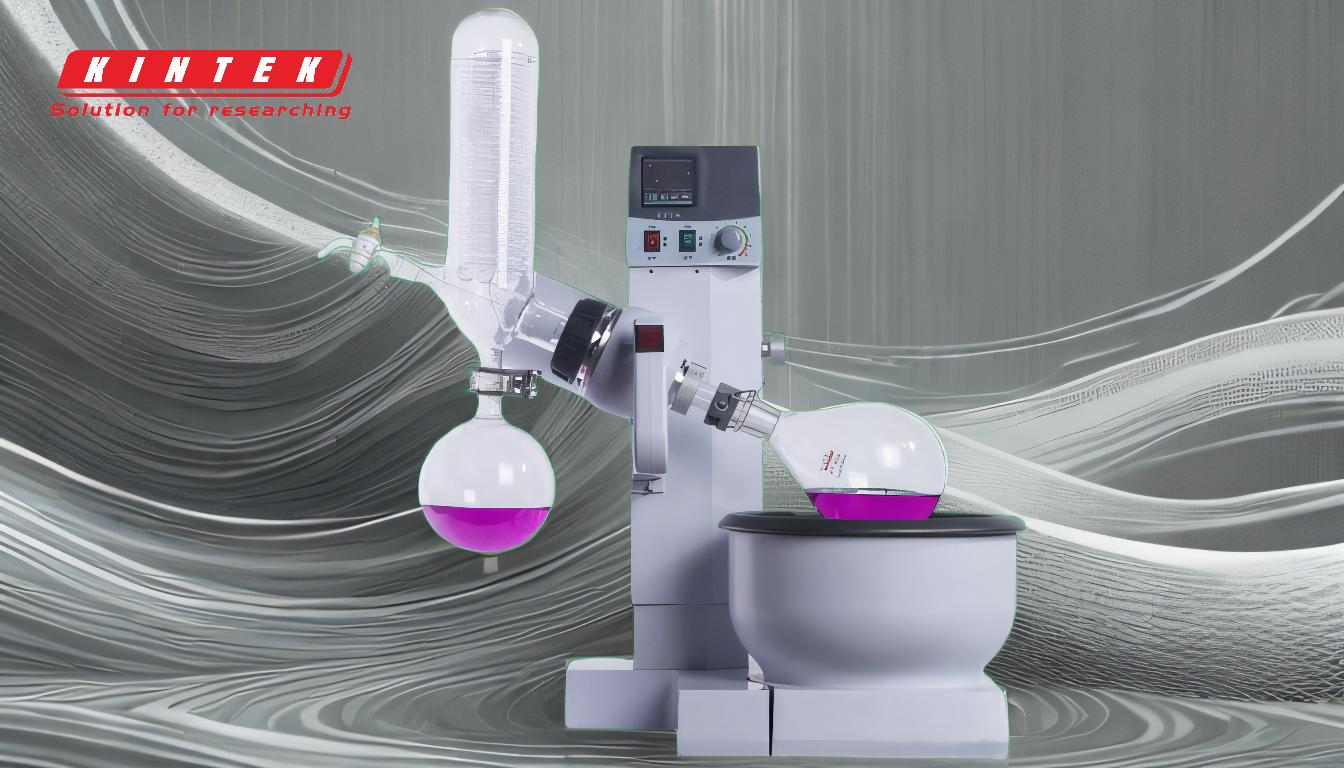Distilling alcohol using a rotary evaporator involves a combination of reduced pressure, controlled heating, and rotation to efficiently separate the alcohol (solvent) from the sample. The process begins by reducing the pressure in the system using a vacuum pump, which lowers the boiling point of the alcohol. The sample is placed in a rotating flask, which creates a thin film of the solution on the inner walls, increasing the surface area for evaporation. The flask is heated in a water bath, and the evaporated alcohol is condensed in a cooled condenser before being collected in a receiving flask. This method is highly efficient and widely used in laboratories for solvent recovery and concentration.
Key Points Explained:

-
Reduction of Pressure Using a Vacuum Pump:
- The rotary evaporator operates under reduced pressure, achieved by a vacuum pump. This reduction in pressure lowers the boiling point of the alcohol, allowing it to evaporate at lower temperatures. For example, ethanol, which normally boils at 78.37°C at atmospheric pressure, can boil at much lower temperatures (e.g., 30-40°C) under vacuum conditions. This minimizes the risk of thermal degradation of heat-sensitive compounds in the sample.
-
Rotation of the Evaporation Flask:
- The flask containing the alcohol and sample is rotated at a constant speed, typically between 150-200 rpm. This rotation creates a thin film of the solution on the inner walls of the flask, significantly increasing the surface area available for evaporation. The larger surface area accelerates the evaporation process, making it more efficient than traditional distillation methods.
-
Heating the Sample in a Water Bath:
- The evaporation flask is partially immersed in a heated water bath, usually maintained at 30-40°C. The heat applied to the flask provides the energy required for the alcohol to evaporate. The temperature is carefully controlled to ensure that the alcohol evaporates without overheating the sample, which could lead to decomposition or loss of volatile compounds.
-
Condensation of the Evaporated Alcohol:
- As the alcohol evaporates, it travels through the condenser, which is cooled to temperatures between -10°C and 0°C. The cold surface of the condenser causes the alcohol vapor to condense back into a liquid. The condensed alcohol then flows into a receiving flask, where it is collected for further use or disposal.
-
Collection of the Distillate:
- The condensed alcohol is collected in a separate flask, known as the distillate flask. This flask is typically placed at the end of the condenser and is designed to securely hold the recovered solvent. The collection process is continuous, allowing for efficient recovery of the alcohol from the sample.
-
Components of the Rotary Evaporator:
- The main components involved in the distillation process include:
- Heat Bath: Provides controlled heating to the evaporation flask.
- Rotor: Rotates the flask to create a thin film of the solution.
- Condenser: Cools the evaporated alcohol, causing it to condense.
- Solvent Trap (Distillate Flask): Collects the condensed alcohol.
- Vacuum Pump: Reduces the pressure in the system, lowering the boiling point of the alcohol.
- Bump Trap: Prevents the sample from splashing into the condenser during vigorous boiling.
- The main components involved in the distillation process include:
-
Advantages of Using a Rotary Evaporator:
- Efficiency: The combination of reduced pressure, rotation, and heating allows for rapid and efficient evaporation of the alcohol.
- Temperature Control: The ability to operate at lower temperatures minimizes the risk of thermal degradation.
- Scalability: Rotary evaporators can be used for both small-scale and large-scale distillation processes.
- Versatility: Suitable for a wide range of solvents, including ethanol, methanol, and acetone.
-
Applications in Alcohol Distillation:
- Rotary evaporators are commonly used in laboratories for the distillation of alcohol from various samples, including:
- Cannabis Extraction: Used to recover ethanol from cannabis extracts, leaving behind concentrated cannabinoids.
- Pharmaceuticals: Used to concentrate active pharmaceutical ingredients (APIs) by removing solvents.
- Food and Beverage Industry: Used to concentrate flavors and aromas by removing alcohol or other solvents.
- Rotary evaporators are commonly used in laboratories for the distillation of alcohol from various samples, including:
-
Safety Considerations:
- Vacuum Pressure: Proper handling of the vacuum system is essential to prevent implosion or explosion of the glassware.
- Temperature Control: Careful monitoring of the water bath temperature is necessary to avoid overheating the sample.
- Chemical Compatibility: Ensure that all components of the rotary evaporator are compatible with the solvents being used.
In summary, distilling alcohol on a rotary evaporator is a highly efficient and controlled process that leverages reduced pressure, rotation, and heating to separate and recover alcohol from a sample. The method is widely used in various industries due to its precision, scalability, and ability to operate at lower temperatures, making it ideal for heat-sensitive materials.
Summary Table:
| Key Aspect | Description |
|---|---|
| Reduced Pressure | Lowers boiling point of alcohol, enabling evaporation at lower temperatures. |
| Rotation of Flask | Creates a thin film, increasing surface area for faster evaporation. |
| Heating in Water Bath | Provides controlled heat to evaporate alcohol without overheating the sample. |
| Condensation | Cools alcohol vapor into liquid for collection in a receiving flask. |
| Components | Includes heat bath, rotor, condenser, solvent trap, vacuum pump, and bump trap. |
| Advantages | Efficient, precise temperature control, scalable, and versatile. |
| Applications | Cannabis extraction, pharmaceuticals, and food/beverage industry. |
| Safety Considerations | Proper vacuum handling, temperature control, and chemical compatibility. |
Discover how a rotary evaporator can optimize your lab processes—contact us today for expert advice!










